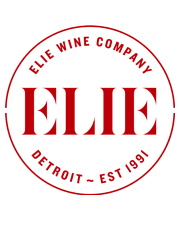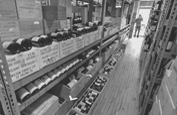Isabel Ferrando’s Châteauneuf-du-Pape: Old-Vine Grenache is “The Heart of Our Vineyards and the Soul of Our Wine” and Old-Vine Whites (6-Bottle Assortment, $299)
To Blend or Not to Blend
The magic of the blend is the keystone in Châteauneuf-du-Pape’s rock-solid reputation; fifteen varieties are legally permitted in the appellation, and the proportion of each used in the final cuvée is a reflection of the vineyard’s potential, the estate’s philosophy and the vigneron’s artistry. The palette is juice, the canvas is the élevage and on opening day, and many years to come, the exhibition wears the familiar embossed insignia of a Châteauneuf-du-Pape bottle.
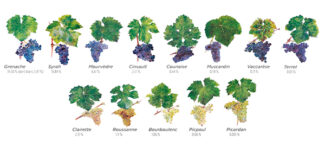
But is blending always the goal? Red wine comprises 95% of Châteauneuf-du-Pape’s output, and most of it is built around the Big Four—Grenache, Syrah, Mourvèdre and more recently, Cinsault. But as a quartet, they are hardly equal: As of 2014, 73% of the vineyards in the appellation were planted to Grenache, with Mourvèdre making up about 7% and Syrah, just under three percent—a number that may soon be supplanted by Cinsault as Syrah continues to lose popularity in the region. Even so, so dominant is Grenache in most blends that a winemaker would likely have to provide a vivisection of varietal profiles to explain how each trace addition affects the final cuvée. The blending spectrum in Châteauneuf-du-Pape, therefore, covers extremes: Château de Beaucastel frequently uses all the allowable grapes in their cuvée while another of Châteauneuf’s most important names, Château Rayas, uses only Grenache.
The Grenache
Despite its potential for splendor in the glass, Grenache has never made the leap into the rarified atmosphere of ‘noble grapes.’ But in the right hands, grown in the correct lieu-dit and farmed correctly, it can be as expressive of terroir as Pinot Noir and as complex and age-worthy as Cabernet Sauvignon. In Châteauneuf-du-Pape, it produces most favorably on sandy soils that provide delicacy and finesse, but where there is also limestone for structure, red clay for the development of rich (but not harsh) tannins and the small stones known as ‘galets’ for power. For a grape that produces such bold and muscular wines, Grenache is thin-skinned and not overly acidic, so it must be picked at an optimum period of phenolic ripeness to avoid becoming flabby and overly alcoholic. Vine age is of extreme importance for Grenache, with younger cultivars making pale-colored and often mediocre wines—60 -100 years appears to be an ideal age for the production of wine of consistently good quality.
The Grenachiste: Isabel Ferrando
If a Grenachiste is a loyalist who fights for Grenache, it would be hard to find a High Priestess more qualified than Isabel Ferrando. A former banker, she learned winemaking at Domaine Raspail-Ay in Gigondas deepened by the tutelage of the late legendary winemaker Henri Bonneau, and in 2003, purchased the seventy-year old Domaine Saint-Préfert from the Serre family, one of the region’s first domains to estate bottle. That year, the property stood at a little over thirty acres, all in the Les Serres lieu-dit south of the village of Châteauneuf.
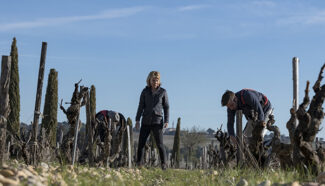
Once a successful first vintage was in the cellar, Ferrando began to purchase more land in CdP, expanding her holdings to its current 55 acres. Among her acquisitions was a small parcel of old-vine Grenache vines that became Domaine Isabel Ferrando ‘Colombis.’ Meanwhile, in 2013, Domaine Saint Préfert earned its certification for using 100% biodynamic farming, an agricultural technique that is somewhat easier pull off in Châteauneuf thanks to the sporadic but predictable Mistral winds that naturally protect vines from pests and mildew.
Still, it is Ferrando’s ever-growing expertise and hands-on winemaking that produces her outstanding portfolio. Says ‘The Grenachiste’: “There is no secret formula to making great wines in Châteauneuf. I work with a young team who is always open to new ideas. We rely on tradition without being trapped by it, working with whole-cluster fermentations without added yeasts because we discovered that it increased freshness in the wines and lowered alcohol, giving the wines vibrancy. Aging occurs in a mix of concrete and used foudres for up to 18 months.”
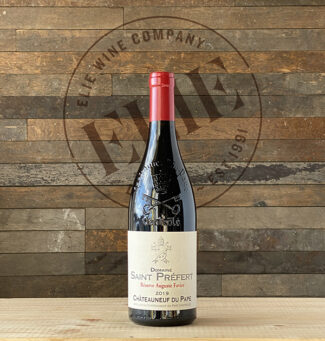 Domaine Saint Préfert, Châteauneuf-du-Pape ‘Réserve Auguste Favier’2019 ($80)
Domaine Saint Préfert, Châteauneuf-du-Pape ‘Réserve Auguste Favier’2019 ($80)
(1 Bottle)
The eponymous August Favier was Isabel Ferrando’s maternal grandfather; the lieu-dit that produces this blend— 85% Grenache and 15% Cinsault—is also named for an original owner. Les Serres, a vineyard in the southernmost part of Châteauneuf-du-Pape, takes its name from Fernand Serre, who planted it in 1928. The grapes are hand-picked and vinified separately; the Grenache is aged in cement and the Cinsault in 600-liter barrels. Floral and exotic, the wine expresses a full-bodied core of blackberry draped with a lacy texture throughout, showing rich cassis and raspberry coulis flecked with the garrigue herbs that are native to the area. A long, elegant finish with a surprisingly silky tannic edge.
 Domaine Saint Préfert, Châteauneuf-du-Pape ‘Classique’ 2019 ($52)
Domaine Saint Préfert, Châteauneuf-du-Pape ‘Classique’ 2019 ($52)
(1 Bottle)
With a base cuvée of 85% Grenache and 5% each of Syrah, Mourvèdre, and Cinsault, aged entirely in concrete tanks, is classic varietal choice as well as in name. Vinified from middle-aged vines—30 years old, tops—this wine is an expression of exuberance crammed with juicy raspberry and bright cherry and light hints of licorice. The sharp subcurrents of smoke and minerality provide a clue that these vines, and the wines they produce, will continue to improve with age.
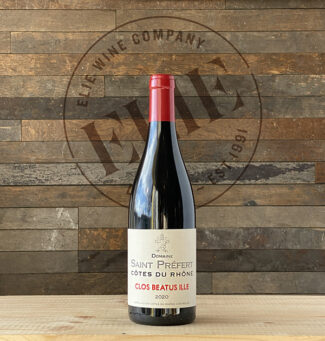 Domaine Saint Préfert, Côtes-du-Rhône ‘Clos Beatus Ille’ 2020 ($29)
Domaine Saint Préfert, Côtes-du-Rhône ‘Clos Beatus Ille’ 2020 ($29)
(3 Bottles)
‘Beatus Ille’ is Latin for ‘Happy Man’—it’s a line from Horace’s 2nd Epode and no doubt includes happy women as well. The wine is 85% Grenache blended with about 15% Cinsault from two parcels—La Lionne in the Sorgues district, just at the southern border of Châteauneuf-du-Pape and another parcel in Vedène. It also contains a bit of Syrah from Châteauneuf-du-Pape. A supple and affordable entryway into Isabel Ferrando’s world, the wine shows the traits of the great Crus in Southern Rhône in an approachable package; cassis, plum and fresh red berries with hints of Asian spice and truffles.
 Domaine Saint Préfert, Châteauneuf-du-Pape Blanc2020 ($80)
Domaine Saint Préfert, Châteauneuf-du-Pape Blanc2020 ($80)
(1 Bottle)
This wine is a blend of 60% Clairette and 40% Roussanne, and is moderately acidic with a nose that displays honeysuckle, acacia flower and peach. The Roussanne lends a rich tannic structure while the Clairette offers minerality and the region’s characteristic salinity.
This week’s package offering is comprised of the four wines featured above: One of each of the three cuvées of Châteauneuf-du-Pape and three of Côtes-du-Rhòne for a total of six bottles at $299. The quantity of each included is, also, indicated in the write-up about the wine.
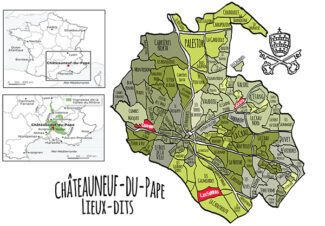
Also, from Domaine Saint Préfert
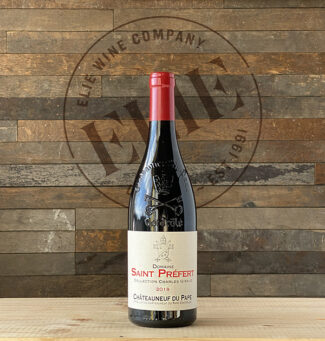 Domaine Saint Préfert, Châteauneuf-du-Pape ‘Collection Charles Giraud’2019 ($159)
Domaine Saint Préfert, Châteauneuf-du-Pape ‘Collection Charles Giraud’2019 ($159)
60% Grenache, 35% Mourvèdre and 5% Syrah, Isabel Ferrando’s ‘tête de cuvée’ is made from the oldest vines in two parcels—les Serres and le Cristia. The former features the famous, multipurpose galet stones of Châteauneuf that retain heat and night and protect the soil from erosion. Le Cristia is a sandy block with drainage ideal for Mourvèdre’s root system, which does not produce well otherwise. The wine shows concentrated boysenberry and violet pastille and candied fruit and bright, chewy back-end lift. As Auguste Favier was Isabel Ferrando’s maternal grandfather, Charles Giraud was her father’s father.
 Domaine Préfert (Isabel Ferrando), Châteauneuf-du-Pape ‘Colombis’ 2019 ($159)
Domaine Préfert (Isabel Ferrando), Châteauneuf-du-Pape ‘Colombis’ 2019 ($159)
Isabel Ferrando affixes her name to the mono-varietal wines she produces at Domaine Préfert. ‘Colombis’ is 100% Grenache, but a blend from three parcels in the western part of the appellation: Lieu-dit Colombis, featuring sandy soils, les Roues, where clay lies just beneath the surface, and le Cristia (not far from Château Rayas), where sand again predominates. The vines average 60 years-old and the concentrated juice from the small clusters produce a wine that critic Jeb Dunnuck referred to as “One of my favorite wines in the world.” Expansive in bouquet and again on the palate, the wine shows spice-accented currant preserves with incense and cola with crisp mineral undertones and an intensely long finish framed by velvety, well-integrated tannins.
The Exception in ‘Vin d’Exception’
Pure Cinsault, Pure Audacity
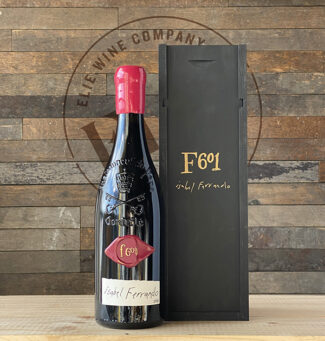 Domaine Préfert (Isabel Ferrando), Châteauneuf-du-Pape ‘F601’ 2018 ($850)
Domaine Préfert (Isabel Ferrando), Châteauneuf-du-Pape ‘F601’ 2018 ($850)
‘F601’ may sound like an unpoetic name for a lieu-dit, and in fact, it is an arid block in the southern part of the estate. It is also atypical of the terroirs of Châteauneuf-du-Pape; fifteen feet below the surface, sand made of degraded quartz can be found and a bit higher up, extra moisture is lodged in a fine layer of blue clay fed by the mica gravel and rolled pebbles already visible at ground level. Of this remarkable habitat for Cinsault Isabel Ferrando writes, “I needed 16 years of observation and apprenticeship to find the audacity to throw away the rule book and forge a personal relationship with this terror, guided by instinct and sensuality. With the 2018 vintage, I am launching ‘F601, and for the first time, the pure and absolute expression of the fusion between this block of land and the venerable Cinsault vines planted on it in 1928. At this defining moment in my life, I am happy to share with you my sense of wonder in this iconic Châteauneuf-du-Pape. Welcome to F601!”
Rich And Rare: White Châteauneuf-du-Pape en Magnum
 Domaine Saint Préfert, Châteauneuf-du-Pape Blanc 2020 ($189) – 1500 ml
Domaine Saint Préfert, Châteauneuf-du-Pape Blanc 2020 ($189) – 1500 ml
Before the wine, why the magnum? Surface area plays a tremendous role in the changes that a wine undergoes during élevage and later, ‘en bouteille’, and these changes happen at a rate that is in proportion to the size of the container. In a magnum—roughly twice the size of a conventional wine bottle—the aging process is slowed down and the wine will keep fresher longer; a plus if the wine is white. This wine is a blend of 60% Clairette and 40% Roussanne from the Serres lieu-dit, where galets, gravel and blue clay abound. It ages on lees for six months in large oak barrels, one third of which is new, one third year-old and the last third two year-old barrels. Moderately acidic, the nose shows honeysuckle, acacia flower and peach with the Roussanne lending a rich tannic structure and the Clairette offering minerality and the region’s characteristic salinity.
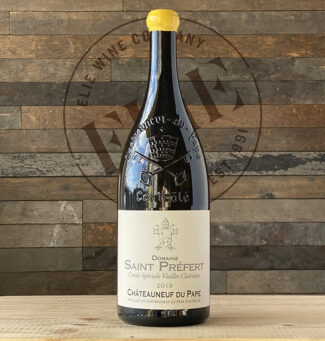 Domaine Saint Préfert, Châteauneuf-du-Pape Blanc’Cuvée Spéciale Vieilles Clairettes’ 2019 ($432) – 1500 ml
Domaine Saint Préfert, Châteauneuf-du-Pape Blanc’Cuvée Spéciale Vieilles Clairettes’ 2019 ($432) – 1500 ml
Only produced ‘en magnum’, this is a heavily allocated gem with less than a thousand bottles made and even fewer exported. 100% Clairette from 100-year-old vines in the dry-farmed lieu-dit ‘Quartier des Serre’ renowned for being one of the most sun-drenched plots in the appellation as well as nurturing vines in well-drained, river-rolled pebble soil. An exquisite, unctuous expression of an under-appreciated varietal, the wine reflects both sun and sand with warm notes of honey, quince jam, creamy lemon curd and pink grapefruit acidity as a backbone.
Notes on Vintages 2018, 2019, 2020
Vintage 2018
The quintessence of a year that the old winemaker’s cliché refers to ‘a vintage made in the vineyard’—based on the difficulty that growers had bringing in the harvest. Rains in May and June created a poor fruit set for Grenache, and the threat of mildew was redoubled by the failure of the mistral; a rare occurrence in Châteauneuf-du-Pape. Humidity skyrocketed, making 2018 the dampest year since 1973, and organic farmers grew frustrated that natural treatments were washed away by un-forecasted rain. The result was a harvest that in particular showed a 40%-60% reduction in Grenache. Syrah and Mourvèdre fared better, and these varieties tend to be more pronounced in the blends.
Vintage 2019
Grenache, however, enjoyed a marvelous renaissance in 2019, and for this sun, heat and wind-loving varietal, the vintage was ideal. An abundant fruit set was followed by three heat waves interspersed with rain and more moderate temperatures, and as a result, there was no heat stress for the vines, and ripening never shut down. Growers were able to pick at optimum ripeness and nothing much had to be done in the vineyard. The fruit’s health carried through to the cellar, with many growers reporting that their vinification were fast and efficient.
Vintage 2020
Following the extreme heat of 2019, growers were hoping for plenty of rainfall over the winter to replenish aquafers, and they got it. An astonishing 15 -20 inches of rain fell between October and December, and a mild early spring saw vine buds break nearly two weeks earlier than 2019. The summer was hot, but not unreasonably so; rains were moderate and frequent enough to prevent heat stress. Harvest for white grapes began in the third week of August, and the 2020 vintage is extremely strong in this category, however small (only 5% of Châteauneuf-du-Pape’s total). It is characterized by elegance and beauty, with a nose marked by citrus and stone fruit and a palate that combines balanced acidity with a prolonged finish.
- - -
Posted on 2022.02.05 in Châteauneuf-du-Pape, France, Wine-Aid Packages, Southern Rhone | Read more...
Give the Gift of Membership to ‘The Champagne Society’: Six Months ($279) or Twelve Months ($499) + STANDOUT DOZEN OF THE YEAR: Buy All for $479
A Membership Subscription to ‘The Champagne Society’ Gift
Lily Bollinger once said, “I only drink champagne when I’m happy and when I’m sad. Sometimes I drink it when I’m alone. When I have company, I consider it obligatory; I trifle with it if I’m not in a hurry and drink it when I am, otherwise I never touch the stuff unless I am thirsty.”
Not only is Champagne the quintessential drink of celebration, it has traditionally been a gift given with ramped-up sentiments. This year we are offering a couple of variations on this theme, beginning with an opportunity to gift a special someone a six-month or twelve-month membership to The Champagne Society. Our pick for December, Champagne Fleury, will be packaged in a wrap-ready gift box along with a congratulatory certificate explaining what lies ahead in bi-monthly installments:
Six-Month Membership Gift ($279) – Bimonthly
You will take home a pre-packaged, ready-for-gift-wrapping box containing The Champagne Society December Selection bottle, Champagne Fleury, with a certificate congratulating the recipient on their new membership to the Champagne Society, a select community of like-minded folks who appreciate the exceptional in life and recognize that wine is a superlative among man’s culinary creations. Then, in February and April, they are eligible to receive two more installments, one Champagne bottle each month (described in detail, in advance, by email), which they can stop by the store to pick up in person or have shipped directly to their home at no additional cost.
Twelve-Month Membership Gift ($499) – Bimonthly
A full year’s membership in the Champagne Society includes a pre-packaged, ready-for-wrapping gift box containing The Champagne Society December Selection bottle, Champagne Fleury, along with a congratulatory certificate informing the recipient that they are now part of the Champagne Society, whose members are eligible for discounted prices on highly allocated Champagne, many bought directly, and many available only through Elie Wine Company. Then, in February and April, June, August and October, they are eligible to receive five more installments, one bottle of Champagne each month (described in detail, in advance, by email), which they can stop by the store to pick up in person or have shipped directly to their home at no additional cost.
Three-Bottle Gift Box
Choose three bottles from this year’s ‘Standout Dozen’ (below) and it will be pre-packaged for you to gift-paper wrap and put under the tree or gift to express appreciation.
A third option, of course, is to choose any number of wines from this year’s Standout Dozen, and we will package them in a gift box ready for wrapping. Or all 12 bottles for ($479).
STANDOUT DOZEN OF THE YEAR 2021
Among the multitude of wines we taste every year, there are a select few that we believe genuinely represent over-achievement by a winemaking team, both in terms of the quality of the product and the innovation used in technique. Younger winemakers tend to be iconoclastic in their approach to the craft, but when it’s done for the wrong reasons, the results are often forgettable. These twelve wines represent the best of the best in wines that we’ve sampled and purchased over the past twelve months; many were created by old friends, and many were new discoveries.
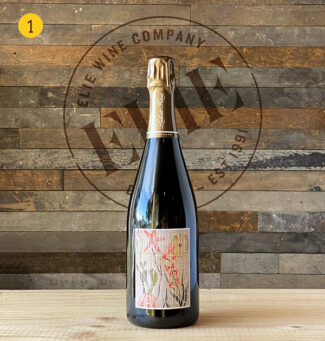 1. Champagne Laherte Frères, ‘Blanc de Blancs’ Brut Nature ($53) (Champagne, France): (Disgorged January 2021) Coteaux Sud d’Epernay is a lesser-known Champagne sub-region sandwiched between the Côtes des Blancs and the Vallée de la Marne; there, Aurélien Laherte—a devoted practitioner of organic and biodynamic viticulture—is turning heads. Dynamic and innovative, ‘Blanc de Blancs’ Brut Nature is drawn from the best parcels of Chardonnay from the southern slopes of Epernay and the Côte des Blancs. Primary fermentation takes places in foudres and barrels with regular lees stirring; the wine goes through partial malolactic fermentation and has zero dosage, producing a Blanc de Blancs representative of the purity and minerality of Chardonnay found in the chalky soils of the area.
1. Champagne Laherte Frères, ‘Blanc de Blancs’ Brut Nature ($53) (Champagne, France): (Disgorged January 2021) Coteaux Sud d’Epernay is a lesser-known Champagne sub-region sandwiched between the Côtes des Blancs and the Vallée de la Marne; there, Aurélien Laherte—a devoted practitioner of organic and biodynamic viticulture—is turning heads. Dynamic and innovative, ‘Blanc de Blancs’ Brut Nature is drawn from the best parcels of Chardonnay from the southern slopes of Epernay and the Côte des Blancs. Primary fermentation takes places in foudres and barrels with regular lees stirring; the wine goes through partial malolactic fermentation and has zero dosage, producing a Blanc de Blancs representative of the purity and minerality of Chardonnay found in the chalky soils of the area.
*click on bottle for more info
 2. Domaine Jean Vacheron, 2019 Sancerre ($48) (White Loire, France): Two young cousins, Jean-Laurent and Jean-Dominique Vacheron, have transformed an elite estate into an elite biodynamic estate. Having inherited some of the most coveted parcels in the appellation and then, purchasing more of the same, the cousins are trying a Burgundian approach to Sancerre winemaking, with parcels being vinified by terroir and blends varying from year to year. The 2019 contains 20% juice from single-vineyard plots, hand harvested and fermented on indigenous yeasts in a combination of cement and stainless-steel tank. It shows bright grapefruit notes with gunflint, sea salt and lime zest.
2. Domaine Jean Vacheron, 2019 Sancerre ($48) (White Loire, France): Two young cousins, Jean-Laurent and Jean-Dominique Vacheron, have transformed an elite estate into an elite biodynamic estate. Having inherited some of the most coveted parcels in the appellation and then, purchasing more of the same, the cousins are trying a Burgundian approach to Sancerre winemaking, with parcels being vinified by terroir and blends varying from year to year. The 2019 contains 20% juice from single-vineyard plots, hand harvested and fermented on indigenous yeasts in a combination of cement and stainless-steel tank. It shows bright grapefruit notes with gunflint, sea salt and lime zest.
*click on bottle for more info
 3. Domaine Michel Briday, 2019 Rully ($30) (White Burgundy, France): Founded in 1976 by Michel and Lucette Briday, the original 15 acres has grown to 38, spread across the municipalities of Rully, Bouzeron, and Mercurey. Under the management of Michel’s son and daughter-in-law, Stéphane and Sandrine, the domain has forged a reputation for producing Côte Chalonnaise wines with a superb ratio between quality and price. 2019’s Rully Blanc is a blend of four parcels; the Chaponnières and Saint Jacques climats bring finesse and elegance, while Crée, a stony terroir below the Premiers Crus Les Pierres and Moulène, lends power and substance. Premier Cru La Bergerie is a deep clay soil adding hints of citrus and spice spring backed by a spine of vibrant acidity.
3. Domaine Michel Briday, 2019 Rully ($30) (White Burgundy, France): Founded in 1976 by Michel and Lucette Briday, the original 15 acres has grown to 38, spread across the municipalities of Rully, Bouzeron, and Mercurey. Under the management of Michel’s son and daughter-in-law, Stéphane and Sandrine, the domain has forged a reputation for producing Côte Chalonnaise wines with a superb ratio between quality and price. 2019’s Rully Blanc is a blend of four parcels; the Chaponnières and Saint Jacques climats bring finesse and elegance, while Crée, a stony terroir below the Premiers Crus Les Pierres and Moulène, lends power and substance. Premier Cru La Bergerie is a deep clay soil adding hints of citrus and spice spring backed by a spine of vibrant acidity.
*click on bottle for more info
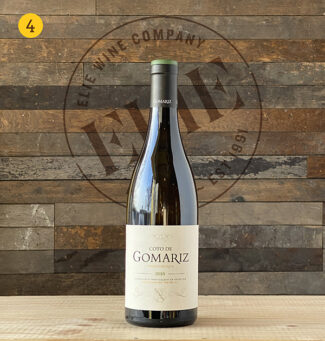 4. Coto de Gomariz, 2018 Ribeiro ($24) (White Galicia, Spain): Coto de Gomariz is located in an ideal winegrowing zone near the eastern edge of Galicia, where the slopes overlook the Avia river. The 66 acres are managed by owner Ricardo Carreiro and his winemaker Xosé Lois Sebio, who make the most of the unique microclimate (schist, granite and sandy soils) through a cornucopia of local white wine varieties including Treixadura, Godello, Loureira and Albariño. A blend of all four, Ribeiro Blanco 2018 is produced in relatively tiny quantities (around 60,000 bottles) and shows itself as aromatic with wild herbs and spring flowers, meaty with crisp stone fruit and a commendably long finish.
4. Coto de Gomariz, 2018 Ribeiro ($24) (White Galicia, Spain): Coto de Gomariz is located in an ideal winegrowing zone near the eastern edge of Galicia, where the slopes overlook the Avia river. The 66 acres are managed by owner Ricardo Carreiro and his winemaker Xosé Lois Sebio, who make the most of the unique microclimate (schist, granite and sandy soils) through a cornucopia of local white wine varieties including Treixadura, Godello, Loureira and Albariño. A blend of all four, Ribeiro Blanco 2018 is produced in relatively tiny quantities (around 60,000 bottles) and shows itself as aromatic with wild herbs and spring flowers, meaty with crisp stone fruit and a commendably long finish.
*click on bottle for more info
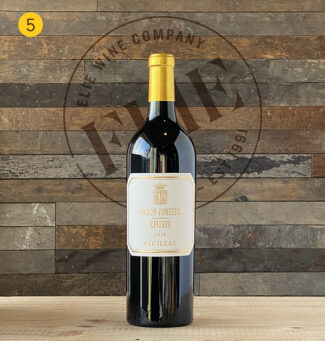 5. Château Pichon Lalande ‘Pichon Comtesse Réserve’, 2018 Pauillac ($69) (Red Bordeaux, France): Good fences may make good neighbors, but in the case of Pichon Lalande, they also make good winemakers. The property is located only a vine away from Château Latour, with perfect access to the Gironde River, and sits across the road from Pichon Baron. The terroir of Château Pichon Lalande is deep gravel with clay and limestone soil, and below that is a layer of sandstone, marl, and limestone. The powerful 2018 opens slowly to offer glimpses of dusty soil, Sichuan pepper, garrigue and tobacco over a core of warm black cherries, cassis and blackberry pie plus a waft of toast and star anise.
5. Château Pichon Lalande ‘Pichon Comtesse Réserve’, 2018 Pauillac ($69) (Red Bordeaux, France): Good fences may make good neighbors, but in the case of Pichon Lalande, they also make good winemakers. The property is located only a vine away from Château Latour, with perfect access to the Gironde River, and sits across the road from Pichon Baron. The terroir of Château Pichon Lalande is deep gravel with clay and limestone soil, and below that is a layer of sandstone, marl, and limestone. The powerful 2018 opens slowly to offer glimpses of dusty soil, Sichuan pepper, garrigue and tobacco over a core of warm black cherries, cassis and blackberry pie plus a waft of toast and star anise.
*click on bottle for more info
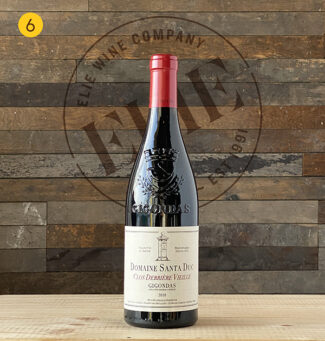 6. Domaine Santa Duc ‘Clos Derrière Vieille’, 2018 Gigondas ($56) (Red Southern Rhône, France): In the verdant environs of Gigondas, heritage is as deep as the iron-rich soils. Yves Gras, Domaine Santa Duc’s winemaker for 32 years, became a standard bearer for innovation with his elegant wines; he replaced barrels with 3600-liter casks to tone down the oak and championed a greater percentage of Mourvèdre used in cuvées. His ongoing quest for cooler terroirs capable of producing great wines ultimately took him from the plateau of Gigondas to Châteauneuf-du-Pape (10 miles to the north), where he was able to purchase several choice parcels. ‘Clos Derrière Vieille’ is 80% Grenache 10% Mourvèdre and 10% Syrah; it shows diaphanous aromas of wild cherry, black currant, blackberry and spice framed by dusty tannins and a mineral driven, lingering finish.
6. Domaine Santa Duc ‘Clos Derrière Vieille’, 2018 Gigondas ($56) (Red Southern Rhône, France): In the verdant environs of Gigondas, heritage is as deep as the iron-rich soils. Yves Gras, Domaine Santa Duc’s winemaker for 32 years, became a standard bearer for innovation with his elegant wines; he replaced barrels with 3600-liter casks to tone down the oak and championed a greater percentage of Mourvèdre used in cuvées. His ongoing quest for cooler terroirs capable of producing great wines ultimately took him from the plateau of Gigondas to Châteauneuf-du-Pape (10 miles to the north), where he was able to purchase several choice parcels. ‘Clos Derrière Vieille’ is 80% Grenache 10% Mourvèdre and 10% Syrah; it shows diaphanous aromas of wild cherry, black currant, blackberry and spice framed by dusty tannins and a mineral driven, lingering finish.
*click on bottle for more info
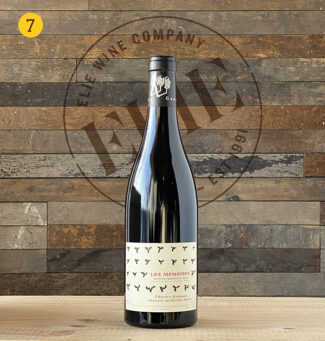 7. Domaine des Roches Nueves ‘Les Mémoires’, 2015 Saumur-Champigny ($60) (Red Loire, France): With vineyards both in the Saumur (Blanc) and Saumur-Champigny (Rouge) appellations, Thierry Germain has become a superstar among biodynamic vine growers in France. His ‘parcellaires’—as he calls his lieu-dit vineyards—are producing some of the most exciting wines in the Loire Valley today. Germain refers to Charly Foucault of Clos Rougeard as his spiritual father. His ‘Les Mémoires’ comes from a 1.7-acre climat, in the commune of Dampierre-sur-Loire, of Cabernet Franc planted in 1904 in silex scree and Turonian limestone. 100% de-stemmed fermentation before 12 months aging in 2500-liter foudre and then six months in bottle. The wine offers a scent of roses on the nose followed by electric red fruits gripped by textured tannins.
7. Domaine des Roches Nueves ‘Les Mémoires’, 2015 Saumur-Champigny ($60) (Red Loire, France): With vineyards both in the Saumur (Blanc) and Saumur-Champigny (Rouge) appellations, Thierry Germain has become a superstar among biodynamic vine growers in France. His ‘parcellaires’—as he calls his lieu-dit vineyards—are producing some of the most exciting wines in the Loire Valley today. Germain refers to Charly Foucault of Clos Rougeard as his spiritual father. His ‘Les Mémoires’ comes from a 1.7-acre climat, in the commune of Dampierre-sur-Loire, of Cabernet Franc planted in 1904 in silex scree and Turonian limestone. 100% de-stemmed fermentation before 12 months aging in 2500-liter foudre and then six months in bottle. The wine offers a scent of roses on the nose followed by electric red fruits gripped by textured tannins.
*click on bottle for more info
 8. Domaine de la Ferté, 2019 Givry ($37) (Red Burgundy, France): High density vineyards are a Burgundian tradition, and nowhere is this more obvious than in the six acres of Domaine de la Ferté’s holdings (among the most renowned Premiers Crus of the appellation) are planted in clay/limestone at 4000 vines per acre. This soil, and in particular, the southeastern and southern exposed slopes, have made Givry a renowned producer of red wine for more than a thousand years. The nose of the 2019 shows violets, strawberries, and blackberries with clove notes wrapping around firm tannins.
8. Domaine de la Ferté, 2019 Givry ($37) (Red Burgundy, France): High density vineyards are a Burgundian tradition, and nowhere is this more obvious than in the six acres of Domaine de la Ferté’s holdings (among the most renowned Premiers Crus of the appellation) are planted in clay/limestone at 4000 vines per acre. This soil, and in particular, the southeastern and southern exposed slopes, have made Givry a renowned producer of red wine for more than a thousand years. The nose of the 2019 shows violets, strawberries, and blackberries with clove notes wrapping around firm tannins.
*click on bottle for more info
 9. Domaines Lupier ‘El Terroir’, 2017 Navarra ($32) (Red Navarra, Spain): Navarra, a region in Northern Spain perhaps better known more for Tempranillo and Cab/Merlot blends, is beginning to develop an international reputation for bright, charming red Garnachas. Elisa Ucar and Enrique Basarte launched Domaines Lupier in 2006, with a goal to rescue old Garnacha vineyards in Navarra’s north while using a non-interventionist approach. The vineyards they work have been farmed biodynamically since Day One, and they now have 27 small plots totaling 42 acres, all at altitudes between 1300 and 2500 feet. The wine is a cool delight, showing black cherry, licorice, cassis and notes of spice and white pepper.
9. Domaines Lupier ‘El Terroir’, 2017 Navarra ($32) (Red Navarra, Spain): Navarra, a region in Northern Spain perhaps better known more for Tempranillo and Cab/Merlot blends, is beginning to develop an international reputation for bright, charming red Garnachas. Elisa Ucar and Enrique Basarte launched Domaines Lupier in 2006, with a goal to rescue old Garnacha vineyards in Navarra’s north while using a non-interventionist approach. The vineyards they work have been farmed biodynamically since Day One, and they now have 27 small plots totaling 42 acres, all at altitudes between 1300 and 2500 feet. The wine is a cool delight, showing black cherry, licorice, cassis and notes of spice and white pepper.
*click on bottle for more info
 10. Domaine de Rochegrès, 2019 Moulin-à-Vent ($27) (Red Beaujolais, France): Moulin-à-Vent is to the ten crus of Beaujolais what Moulin Rouge is to Parisian cabarets: First among equals. Some consumers prefer floral Fleurie and charming Chiroubles, but no Beaujolais shows off a full-bodied, tannic-structure like Moulin-à-Vent. Domaine de Rochegrès covers 13 of the appellation’s 1600 acres, and the name references the greyish granite visible on the surface of the soil. The wine reflects the richness of this terroir with aromatic, electric red fruit in the foreground, evolving toward floral and spicy notes that finish with a touch of oak and elegant tannins.
10. Domaine de Rochegrès, 2019 Moulin-à-Vent ($27) (Red Beaujolais, France): Moulin-à-Vent is to the ten crus of Beaujolais what Moulin Rouge is to Parisian cabarets: First among equals. Some consumers prefer floral Fleurie and charming Chiroubles, but no Beaujolais shows off a full-bodied, tannic-structure like Moulin-à-Vent. Domaine de Rochegrès covers 13 of the appellation’s 1600 acres, and the name references the greyish granite visible on the surface of the soil. The wine reflects the richness of this terroir with aromatic, electric red fruit in the foreground, evolving toward floral and spicy notes that finish with a touch of oak and elegant tannins.
*click on bottle for more info
 11. Can Sumoi ‘Sumoll Garnatxa’, 2019 Penedès ($26) (Red Catalunya, Spain): Pepe Raventós was born to the vine; he spent his childhood picking grapes at Sant Sadurní d’Anoia, home of more than eighty cava producers and the cornerstone of the local economy. It’s also where 21 generations of Pepe Raventós’ family has called home since the 15th century. At 200 feet above sea level, his vineyard Can Sumoi is the highest estate in the Penedès, and it is Raventós’ mission to produce high-altitude wines that define the balance, harmony and austerity of Catalunya; when you drink them—or any wine, for that matter, says Raventós—your mind and spirit should travel to the place of origin. The wine shows boysenberry, cinnamon and pomegranate while combining rusticity with an essential elegance that is, like salinity, a Can Sumoi trademark.
11. Can Sumoi ‘Sumoll Garnatxa’, 2019 Penedès ($26) (Red Catalunya, Spain): Pepe Raventós was born to the vine; he spent his childhood picking grapes at Sant Sadurní d’Anoia, home of more than eighty cava producers and the cornerstone of the local economy. It’s also where 21 generations of Pepe Raventós’ family has called home since the 15th century. At 200 feet above sea level, his vineyard Can Sumoi is the highest estate in the Penedès, and it is Raventós’ mission to produce high-altitude wines that define the balance, harmony and austerity of Catalunya; when you drink them—or any wine, for that matter, says Raventós—your mind and spirit should travel to the place of origin. The wine shows boysenberry, cinnamon and pomegranate while combining rusticity with an essential elegance that is, like salinity, a Can Sumoi trademark.
*click on bottle for more info
 12. Artuke ‘Pies Negros’, 2018 Rioja ($22) (Red Rioja, Spain): ‘Artuke’ is a blended version of the names of the Blanco brothers Arturo and Kike; they produce from 32 different vineyard plots on 54 acres of land in Rioja Alavesa. The vineyards fall within a geographic triangle formed by the villages of Baños de Ebros, Abalos and San Vicente, each with unique terroir. ‘Pies Negros’ is focused fruit from Abalos. 85% Tempranillo and 15% Graciano, the wine is earthy on the nose with smoke, chocolate, black plum and dried blackberry in the mid-palate with soft fennel notes on the finish.
12. Artuke ‘Pies Negros’, 2018 Rioja ($22) (Red Rioja, Spain): ‘Artuke’ is a blended version of the names of the Blanco brothers Arturo and Kike; they produce from 32 different vineyard plots on 54 acres of land in Rioja Alavesa. The vineyards fall within a geographic triangle formed by the villages of Baños de Ebros, Abalos and San Vicente, each with unique terroir. ‘Pies Negros’ is focused fruit from Abalos. 85% Tempranillo and 15% Graciano, the wine is earthy on the nose with smoke, chocolate, black plum and dried blackberry in the mid-palate with soft fennel notes on the finish.
*click on bottle for more info
- - -
Posted on 2022.02.02 in Moulin-à-Vent, Sancerre, Saumur-Champigny, Côte Chalonnaise, Rully, Givry, Pauillac, Bordeaux, France, Beaujolais, Penedes, Burgundy, Champagne, Wine-Aid Packages, Rioja DOC, Loire, Southern Rhone, Navarra, Ribeiro | Read more...
The Champagne Society February 2022 Selection: Champagne André Clouet
Champagne André Clouet
‘Un Jour de 1911 …’
Grand Cru Bouzy
(Grande Montagne in The Montagne de Reims)
Blanc de Noirs, Disgorgement Date: September 2021
Special Price for members of the Champagne Society is $72.
The Landscape of Champagne
Having been defined and delimited by laws passed in 1927, the geography of Champagne is easily explained in a paragraph, but it may take one a lifetime to understand it.
Ninety-three miles east of Paris, Champagne’s production zone spreads across 319 villages and encompasses roughly 85,000 acres. 17 of those villages have a legal entitlement to Grand Cru ranking, while 42 may label their bottles ‘Premier Cru.’ Four main growing areas (Montagne de Reims, Vallée de la Marne, the Côte des Blancs and the Côte des Bar) encompass nearly 280,000 individual plots of vines, each measuring a little over one thousand square feet.
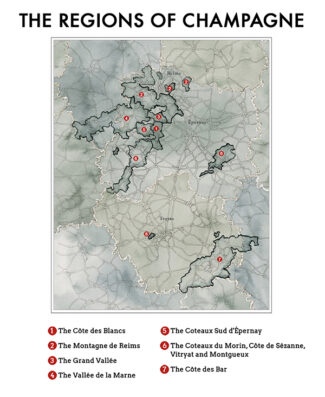
Beyond the overview lies a permutation of particulars; there are nearly as many micro-terroirs in Champagne as there are vineyard plots. Climate, subsoil and elevation are immutable; the talent, philosophies and techniques of the growers and producers are not. Ideally, every plot is worked according to its individual profile to establish a stamp of origin, creating unique wines that complement or contrast when final cuvées are created.
Champagne is predominantly made up of relatively flat countryside where cereal grain is the agricultural mainstay. Gently undulating hills are higher and more pronounced in the north, near the Ardennes, and in the south, an area known as the Plateau de Langres, and the most renowned vineyards lie on the chalky hills to the southwest of Reims and around the town of Epernay. Moderately steep terrain creates ideal vineyard sites by combining the superb drainage characteristic of chalky soils with excellent sun exposure, especially on south and east facing slopes.
Exploring Pinot Country: The Montagne de Reims
Whether based on tradition or technical savvy, the choice of the grape variety and rootstock best suited to a specific plot is an indispensable factor in determining the ultimate success of any lieu-dit, or named vineyard. Whereas most Champagne is a blend of Pinot Noir and Chardonnay, both grapes make unique demands on terroir, and where one may thrive, the other may not. Sandwiched between the Marne and the Vesle Rivers, forming a broad headland of forests and thickets, the Montagne de Reims is particularly suited to the former; Pinot Noir vines carpet the western and northern flanks to form a vast semicircle extend from Louvois to Villers-Allerand, encompassing the famous villages of Bouzy and Ambonnay.
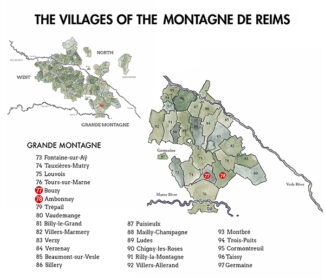
Bouzy and Ambonnay: Twin Grands Crus, Always Rivals
Like Elizabeth I and Mary Queen of Scots, the Grand Crus of Bouzy and Ambonnay co-exist in begrudging mutual respect and rivalry, and unless one figures out how to sign the other’s death warrant, this will continue for the foreseeable future. At its closest point, the distance between the two communes is less than a long drive with a golf club, and each have shored up a reputation for superlative wines from the south side of the Montagne de Reims hill.
With a population just under one thousand, Bouzy is the best known Champagne village to produce still wine (Bouzy Rouge) along with its legendary Pinot Noir-focused sparkling wine. More than nine hundred acres in Bouzy are under vine, with 87% of them Pinot Noir, 12% Chardonnay and a scant 0.2% Meunier. The most prominent Champagne houses with a Bouzy presence are Bollinger, Duval-Leroy, Moët & Chandon, Mumm, Pol Roger and Taittinger.
Nearby Ambonnay shares a nearly identical terroir with Bouzy on the south side of the Montagne de Reims hill, and is similarly appointed, although with slightly less Pinot Noir grown and a bit more Chardonnay—white grapes accounts for about 20% of the vineyards. Like Bouzy, ‘Ambonnay Rouge’ represents a small portion of wine production. Prominent Champagne houses that control Ambonnay vineyards include Duval Leroy, Moët & Chandon, Mumm, Piper Heidsieck, Pol Roger and Roederer.
Champagne André Clouet
A Custodian of Bouzy and Ambonnay
Somewhat less prominent than the powerhouse producers mentioned above is grower-producer Jean-François Clouet of Champagne André Clouet, although Champagne Clouet has been around longer. The Clouet family traces its Bouzy roots to 1492 and at one time was the official printmakers for the court of King Louis XV; the classically pretty labels that grace their Champagne bottles today pay homage to their aesthetic history. Clouet grapes are sourced exclusively from 20 acres of coveted mid-slope vineyards in the Grand Cru villages of Bouzy and Ambonnay.
Born and raised in Bouzy, Jean-François still lives in his family’s 18th century home; with inimitable wit, he refers to himself as ‘a combination of winemaker and circus ringmaster.’ In fact, the French refer to him as ‘chef de cave’—a cellar master. He is arguably the region’s most qualified historian and insists that, without acknowledging the role that the past has played on his winemaking decisions, you can’t truly appreciate his wines.
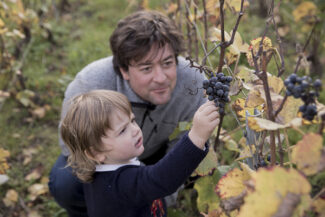 “To understand Champagne as a whole you need to understand its political history,” he says. “Attila the Hun, the Crusaders, the Templars and Marie Antoinette have all walked here; the birth of the monarchy and the Battle of the Cathalunian Fields took place nearby. In 1911, my great grandfather designed the label that graces our bottles today; I like the idea of the work of human hands in pruning, performing the same actions as my grandfather and even the Romans, who planted vines here 2000 years ago.”
“To understand Champagne as a whole you need to understand its political history,” he says. “Attila the Hun, the Crusaders, the Templars and Marie Antoinette have all walked here; the birth of the monarchy and the Battle of the Cathalunian Fields took place nearby. In 1911, my great grandfather designed the label that graces our bottles today; I like the idea of the work of human hands in pruning, performing the same actions as my grandfather and even the Romans, who planted vines here 2000 years ago.”
‘One Day in 1911 …’ A Champagne Fairytale
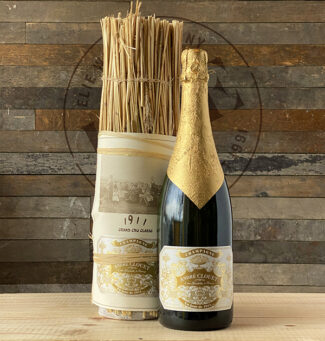
Champagne André Clouet ‘Un Jour de 1911…’ Grand Cru Bouzy, Brut ($72)
Commemorating the year Jean-François Clouet’s great grandfather designed the bottles front label, ‘Un Jour de 1911…’ is the domain’s tête de cuvée, with production limited to 1,911 bottles per disgorgement. Made from 100% Pinot Noir sourced from the Clouet’s ten best lieux-dits in the Grand Cru vineyards of Bouzy, the wine has been aged for six years on the lees—a remarkable span for a non-vintage Champagne. This release had a disgorgement date of September, 2021and is dosed at 6 grams per liter. It is delicately perfumed with sweet rose petal and jasmine and framed in austere minerality and balanced autolytic notes. Despite the relatively recent disgorgement, the mousse presents itself as extraordinarily elegant.
The ‘Dream’ Collection
A Vertical Exploration: Retrospective Spanning A Decade
Champagne André Clouet’s ‘Dream’ collection is a retrospective of Champagne’s top vintages over the past decade or so, each release labeled in a distinct color based on Cadillacs from the 1950s; Jean-François attempt to duplicate a ‘dream’ era for automotive elegance and power. A blend of the sharp, acidic Chardonnays of Mesnil-sur-Oger with the richer Chardonnays of Bouzy, the wines showcase the highest expression of Blanc de Blancs produced by the domain.
Vintage Champagnes represent less than 5 percent of all Champagne production, typically produced only in select vintages. Vintage Champagne is aged for a minimum of three years in the bottle, as opposed to 15 months for non-vintage versions. “Aging is a luxury factor,” says James Beard Award-winning sommelier Belinda Chang: “There’s a lot of painstaking work and labor and real estate required to bring those gorgeous bottles of Champagne to us. Not only are they sourcing grapes from their best vintage, but the grapes are coming from highly venerated vineyards.”

This six-bottle set is an excellent opportunity to sample the nuances of each of a half dozen notable growing seasons for Champagne André Clouet. A limited release of 36 sets were assembled by the producer specially for Elie Wine Co. ($489)
1- 2004 Dream – Champagne André Clouet – Brut
2004 was an extremely good vintage throughout Champagne; a cool spring warmed up in time to ensure a successful budburst and flowering. A sunny summer followed and conditions were so favorable that some producers had to green harvest to curb the overabundance of leaf growth. The previous year’s drought meant that water-tables within the soils were limited, subjecting the vines to slight water stress and concentrating the fruit—a good thing, in this case. Clouet’s 2004 offers a complex core of brioche, apples, citrus and chalky minerality.
2- 2005 Dream – Champagne André Clouet – Brut
2005 was an excellent vintage, just short of outstanding. A dry winter and a bright spring allowed for a successful budburst and flowering, and good weather hung around until July, when persistent rains showers brought both humidity and mildew. Conditions marginally dried out in August, but temperatures were also cooler beyond the one significant heat spike that kick-started ripening. September delivered the warm, steady conditions needed to dry out the vines and push the surviving grapes to phenolic ripeness, while cool nights helped retain essential acidity and aromatics. 2005 ‘Dream’ shows layers of mineral-infused stone fruit on a silky, mid-weight frame, with gorgeous length and a refined, subtle mousse.
3- 2006 Dream – Champagne André Clouet – Brut
Overall, 2006 was average in Champagne, with good wines made only by circumspect vignerons. Flowering was excellent, but the growing season was defined by a markedly dry summer, with June and July delivering a series of searingly hot weeks and a premature ripening of berries. A significant mid-summer thunderstorm pelted various vineyards with hail, following which, the sunny streak did not return until early autumn. A gloomy August brought humidity inspiring rot, mildew and unwanted bouts of botrytis. Fortunately, September saw a return of warm, dry days which helped push the fruit to phenolic ripeness while cool nights were conducive to preserving essential acidity. 2006 Clouet offers wonderful bouquet of apples and poached pear along with buttered brioche and palate rich in salty minerals and a touch of hazelnut praline.
4- 2008 Dream – Champagne André Clouet – Brut
In Champagne, the 2008 vintage was sublime, especially in Bouzy. To earn such distinction, cooler summer weather is almost a requirement—for grapes to reach phenolic ripeness sufficient to harvest, it helps is the process is slow and steady. The only downside of 2008 was the global recession which drove prices downward and effected every aspect of Champagne production. Although the region was hit hard by economics, the 2008 vintage is considered nearly legendary for quality. Clouet’s 2008 expresses the pedigree of the vintage: Complex and nuanced, it boasts dried pear, mint, chamomile, crushed rock, dried flowers and pastry overtones laced together over an acidic core.
5- 2009 Dream – Champagne André Clouet – Brut
2009 was a fabulous vintage in Champagne; a dry winter left the water table low, but spring rains quickly topped them off. Vicious storms popped up in July, hitting Aÿ fairly hard, but Bouzy came through virtually unscathed. August brought warmth and sunshine and enough dry heat to prevent rot and mildew; nights remain cool, and acidity from this vintage may be pronounced. Clouet’s 2009 is a beautifully balanced package, with acids reined in by whirlwind of creamy aromas and caramelized apple, green pear, brioche, lemon-citrus peel on the palate.
6- 2013 Dream – Champagne André Clouet – Brut
Chardonnay grapes were the clear champions in a very average growing season; 2013 suffered from a cold and wet lead-in winter and a spring in which budburst and flowering were delayed. Cooler than normal temperature subjected the vines to millerandage and coulure, cutting yields. Aube and Marne experienced tricky weather throughout much of the season and a July hailstorm further reduced the crop. Among the vintage Champagnes produced, Blanc de Blanc were the most notable, and Clouet’s 2013 is voluptuous and vibrant with lemon oil, lightly-toasted walnuts, crisp yellow apples, acacia honey and a racy, acidic finish.
- - -
Posted on 2022.02.01 in France, The Champagne Society, Champagne | Read more...
Tracing Jurassic Treasures: Diverse Soil and Grape Varieties Produce Boundless Shades and Styles in France’s Jura Mountains. (7-Bottle Package $229)
Jordan Nodel, a treasured patron, perfectly summarized one of this week’s package offerings, Domaine Rolet’s 2018 ‘Rouge Tradition’: “I really enjoyed this bottle. Stylistically it’s often just what I’m looking for: Something with a slight cherry tartness, lively acidity without being overpowering, and not so serious and imposing a wine that I need to think too much if it’s the right time to open the bottle. I often want to feel like I could be drinking a particular wine in a crowded bar in the Marais as opposed to being served in a stuffy restaurant, and this one fits that mood. I had a glass with roast chicken that had a bit of spice to it, and the pairing still felt balanced enough.”
Whatever you are serving tonight, this week’s wine package will walk you through the meal with an ideal pairing for every course, all from the Jura—one of the most diverse and misunderstood appellations in France.
Long before Spielberg was a gleam in evolution’s eye, the Jurassic Park of eastern France was producing unique wines from local varieties like Poulsard and Trousseau, both red, and Savagnin (known locally as Naturé), which is responsible for the region’s idiosyncratic Vins Jaunes, or golden wines.
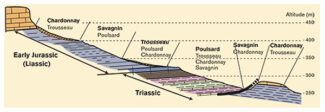
The entire Jurassic era was, in fact, named for tiny Jura; the region’s limestone mountains are representative of the geological developments which occurred around 200 million years ago, and the vine-friendly soil types that predominate here are Jurassic period limestone and marl. About fifty miles north to south, elevations in the appellation vary widely, from the mountainous east, where the topography may reach forty-five hundred feet to the flatter west. The majority of the vines are planted in the Jura are restricted to south-facing slopes in lower-lying land in the west, where the elevation tops out at a thousand feet.
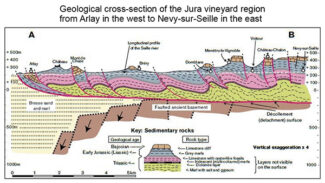
Five distinct AOPs subdivide the Jura; the most important in terms of volume are Arbois and Côtes du Jura, with Crémant du Jura, Macvin and L’Étoile rounding out the quintet.
AOP Macvin du Jura
The most recent region in the Jura to have been granted its own appellation (1991) and the third in France officially recognized as a vin de liqueur. Also called ‘Mistelle,’ such beverages are produced by adding high-strength spirit to unfermented or slightly fermented fruit juice, resulting in a sweet, grapey liqueur, typically between 16 and 22% alcohol by volume. Traditionally served as an aperitif, Macvin is fortified with locally produced Eau-de-Vie de Marc Originaire de Franche-Comté (EDVR), and comes in red, white and rosé, making use of any or all of the Jura’s key grapes—Chardonnay, Savagnin, Poulsard, Pinot Noir and Trousseau. Fittingly, the name ‘Macvin’ is a portmanteau of marc (a neutral spirit made of grape pomace) and ‘vin’.
AOP Arbois
The Jura’s most prolific sub-appellation, Arbois produces both white wine and rosé in great quantities, but has long staked its reputation on reds—about 70% of the Jura’s red wines are produced under the Arbois name. The 2000 acres under vine also contain zones set aside for sparkling wine (Crémant de Jura) and other plots supply fortified Macvin de Jura under its own AOP.
Arbois is hilly, and so situated that the valley slopes catch the morning sunlight and protect vines from winds. The mesoclimate produced by the geography partially explains the regional emphasis on red wines. The appellation covers 13 communes, among them the small village of Pupillin, which contains a patchwork of ‘climats’ that produce wine of particularly high quality. As such, wines from these sites are sold as Arbois-Pupillin.
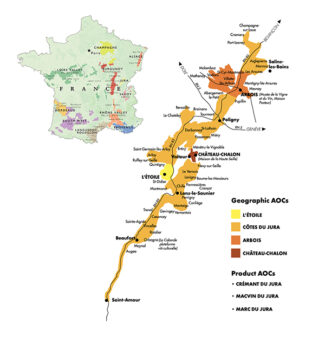
This week’s package offering is comprised of Domaine Rolet’s four featured wines. The quantity of each included is indicated in the write-up about the wine for a total of six bottles at $229.
Domaine Rolet
One of the flagship vineyards in the Jura, Domaine Rolet was created in the early 1940s by Désiré Rolet. When his children sold the 150-acre estate, they wanted new owners who would respect the diverse terroirs on which their property sits, in Arbois, Côtes du Jura, L’Étoile and Crémant du Jura. The torch was passed to the Burgundian group Domaines Devillard, owners of Domaine des Perdrix in Nuits-Saint-Georges and Château de Chamirey in Mercurey, along with the families Flambert and Dupuis. In June, 2018, Cédric Ducoté took over the management of Rolet, and upon his arrival, a commitment to organic agriculture culture was initiated—a transformation which continues to this day. Production is respectable at 350,000 bottles per year.
The meal, as interpreted by the wine of Jura:
(Aperitif with White Vin de Liqueur)
 1. AOP Macvin du Jura – Multi-Vintage Blanc ($33) (1 Bottle): 100% Savagnin, a small-berried, thick-skinned varietal not to be confused with Sauvignon Blanc. A late-ripening grape that can still produce dry white wines with good acidity, Savagnin’s flavor profile is typically citrus and floral with occasional tropical lushness. When blended with locally distilled marc and aged in large oak casks for 24 months, the vin de liqueur takes on a heavy amber color and shows exotic and unctuous notes of orange zest, quince and dried apricot.
1. AOP Macvin du Jura – Multi-Vintage Blanc ($33) (1 Bottle): 100% Savagnin, a small-berried, thick-skinned varietal not to be confused with Sauvignon Blanc. A late-ripening grape that can still produce dry white wines with good acidity, Savagnin’s flavor profile is typically citrus and floral with occasional tropical lushness. When blended with locally distilled marc and aged in large oak casks for 24 months, the vin de liqueur takes on a heavy amber color and shows exotic and unctuous notes of orange zest, quince and dried apricot.
(Starter Course with Oxidative White)
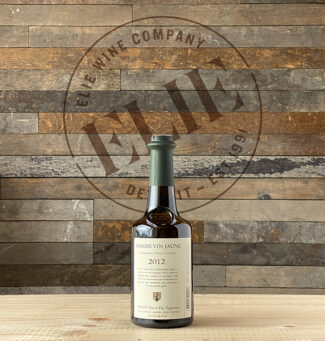 2. AOP Arbois – 2012 Arbois Vin Jaune ($60) (1 Bottle 375 ml): An entirely unique Savagnin personality is uncovered in Vin Jaune, a labor-intensive wine aged under a flor-like cover of yeast. The resultant rich wines are known for their nutty, Fino Sherry-like character, as well their intensity and a lifespan that can exceed 75 years. Rolet’s incarnation shows intense honeyed-walnut and salted almond notes over a wash of dried apple.
2. AOP Arbois – 2012 Arbois Vin Jaune ($60) (1 Bottle 375 ml): An entirely unique Savagnin personality is uncovered in Vin Jaune, a labor-intensive wine aged under a flor-like cover of yeast. The resultant rich wines are known for their nutty, Fino Sherry-like character, as well their intensity and a lifespan that can exceed 75 years. Rolet’s incarnation shows intense honeyed-walnut and salted almond notes over a wash of dried apple.
(Main Course with Dry White)
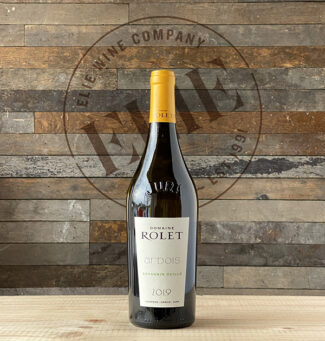 3. AOP Arbois – 2019 ‘Savagnin Ouillé’ ($27) Dry White (2 Bottles): Vin Jaune-styled wine so dominates in the Jura that it is necessary to mention on the label when Savagnin has not been vinified with oxidation. That’s what the word ‘Ouillé’ after ‘Savagnin’ indicates. Grown in grey marl and allowed to fully express its fresh exuberance, this wine is lush and linear, showing spiced mango and ripe peaches behind a mantle of minerality and the region’s characteristic salty notes.
3. AOP Arbois – 2019 ‘Savagnin Ouillé’ ($27) Dry White (2 Bottles): Vin Jaune-styled wine so dominates in the Jura that it is necessary to mention on the label when Savagnin has not been vinified with oxidation. That’s what the word ‘Ouillé’ after ‘Savagnin’ indicates. Grown in grey marl and allowed to fully express its fresh exuberance, this wine is lush and linear, showing spiced mango and ripe peaches behind a mantle of minerality and the region’s characteristic salty notes.
(Main Course with Dry Red)
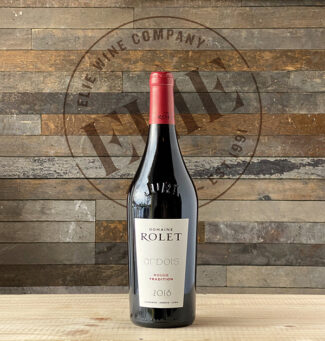 4. AOP Arbois – 2018 ‘Rouge Tradition’ ($23) (3 Bottles):Domaine Rolet vinifies the three varietals in this cuvée (40% Poulsard, 30% Trousseau, 30% Pinot Noir) as mono-grape bottlings, but the blend is essential for the flavors of ‘Rouge Tradition’—spicy cherry, tart cranberry, rich and redolent of rose petals. The vines average 40 years and are grown on red marl.
4. AOP Arbois – 2018 ‘Rouge Tradition’ ($23) (3 Bottles):Domaine Rolet vinifies the three varietals in this cuvée (40% Poulsard, 30% Trousseau, 30% Pinot Noir) as mono-grape bottlings, but the blend is essential for the flavors of ‘Rouge Tradition’—spicy cherry, tart cranberry, rich and redolent of rose petals. The vines average 40 years and are grown on red marl.
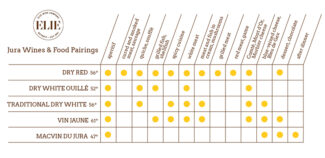
ALSO AVAILABLE FROM THIS ICONIC REGION:
AOP L’Étoile
The well-known ‘star’ of the Jura—named for the star-shaped fossils, gryphées, that can be found in the local limestone-rich soils—is minute in size (185 acres) and in the corresponding production of wine, which is rarely seen outside France. L’Étoile’s terroir, on the other hand, is also seen in Chablis, 110 miles to the northwest. As a result, Chardonnay is the favored varietal in L’Étoile, and like Chablis, these wines are notable for their strikingly fresh minerality. Unlike Chablis, however, Savagnin permitted under the L’Étoile appellation and is used to produce the quintessentially local product, Vin Jaune. It is also blended with Chardonnay to make sweet Vin de Paille, which also contains Poulsard, Jura’s key red grape variety, to add complexity and color. Even so, red wines are not produced under the appellation.
Domaine de Montbourgeau
Jean Gros acceded to the head of the family wine business in 1956; thirty years later, in 1986, his daughter Nicole Deriaux joined the business as vigneronne. Today, she is fully responsible for the domain’s operation, and with three sons waiting in the wings, the baton will likely pass between family members for many years to come. The estate is located in the southwestern part of the Jura, in the commune of L’Étoile (‘the star)—a name that pays homage to the starfish fossils found throughout the appellation. Nicole Deriaux farms twenty acres devoted mostly to Chardonnay, with Savagnin sited in six of those acres and Trousseau and Poulsard rounding out the rest.
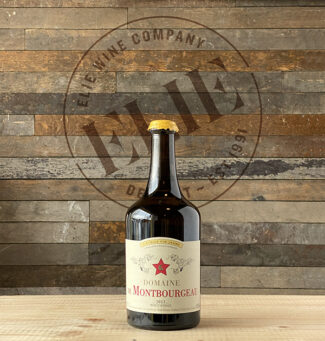 AOP L’Étoile – 2011 L’Étoile Vin Jaune ($89): Befitting the style, this Vin Jaune is 100% Savagnin grown on blue marl rich in limestone. The wine spends one year in small, neutral oak casks followed by six years in larger hogsheads, allowing for the longer, requisite maturation period. The wine displays quince jam notes sheathed in warm, yeasty lemon curd and resonant acidity. Around 3000 bottles made.
AOP L’Étoile – 2011 L’Étoile Vin Jaune ($89): Befitting the style, this Vin Jaune is 100% Savagnin grown on blue marl rich in limestone. The wine spends one year in small, neutral oak casks followed by six years in larger hogsheads, allowing for the longer, requisite maturation period. The wine displays quince jam notes sheathed in warm, yeasty lemon curd and resonant acidity. Around 3000 bottles made.
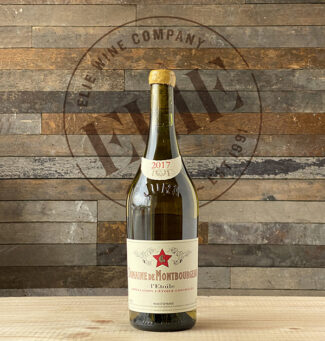 AOP L’Étoile – 2017 ($30):95% Chardonnay with Savagnin topping off the blend, this wine originates on the southeastern slopes of L’Étoile, where vines average 40 years. Following malolactic fermentation, it spends up to three years in neutral oak, giving it what may be considered a ‘typical’ Jura profile for Chardonnay, tasting slightly oxidized, although not nearly in the style referred to locally as ‘sous voile’, or ‘under veil’—referring to the yeasty flor that characterizes Vin Jaune. About 20,000 bottles are produced: It is the winery’s mainstay.
AOP L’Étoile – 2017 ($30):95% Chardonnay with Savagnin topping off the blend, this wine originates on the southeastern slopes of L’Étoile, where vines average 40 years. Following malolactic fermentation, it spends up to three years in neutral oak, giving it what may be considered a ‘typical’ Jura profile for Chardonnay, tasting slightly oxidized, although not nearly in the style referred to locally as ‘sous voile’, or ‘under veil’—referring to the yeasty flor that characterizes Vin Jaune. About 20,000 bottles are produced: It is the winery’s mainstay.
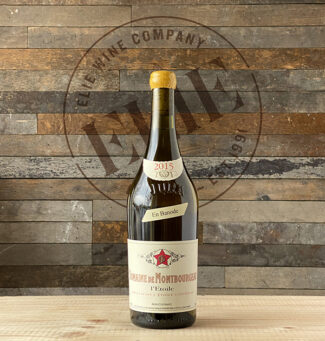 AOP L’Étoile – 2015 ‘En Banode’ ($39): A field blend of Chardonnay and Savagnin from a single plot of white and blue limestone marl where the vines are fifty years old—the estate’s oldest plantings. At 2300 bottles produced, this wine is highly allocated and is only produced in exceptional vintages.
AOP L’Étoile – 2015 ‘En Banode’ ($39): A field blend of Chardonnay and Savagnin from a single plot of white and blue limestone marl where the vines are fifty years old—the estate’s oldest plantings. At 2300 bottles produced, this wine is highly allocated and is only produced in exceptional vintages.
AOP Château-Chalon
In terms of output, the Côtes du Jura is the Jura’s largest sub-appellation and produces wines in a rainbow of hues. It encompasses roughly fifteen-hundred acres and 105 communes, stretching for fifty miles between Champagne-sur-Loue in the north to Saint-Amour in the south.
Despite its size, the terroir of the Côtes is quite homogenous, with local bedrock composed of limestone and marlstone and topsoil alternating between scree and sand that is often rich in mineral clays. The cold winters typical of the region favor tall trellising, to keep the vines away from autumn frosts which regularly occur here in early fall. Savagnin grapes are particularly at risk from this phenomenon, as they must remain on the vine until later in the season to achieve the high levels of ripeness required for the production of Vin Jaune
Jean Bourdy
Dating to the 14th century, Caves Jean Bourdy is today run by brothers Jean-Phillipe and Jean-François, the 15th generation of winemakers at the estate. They farm twenty acres in some of the Jura’s most highly regarded terroirs, included a single acre in Château-Chalon—an appellation dedicated solely to the production of Vin Jaune. Jean Bourdy’s current portfolio includes a multitude of wines of the Jurassic styles, from red blends of Poulsard, Pinot Noir and Trousseau, whites made of Chardonnay or Savagnin to, of course, their much sought-after Château-Chalon. The Bourdys are also known for their wine library and cellar program which has wines from almost every vintage dating back to 1781.
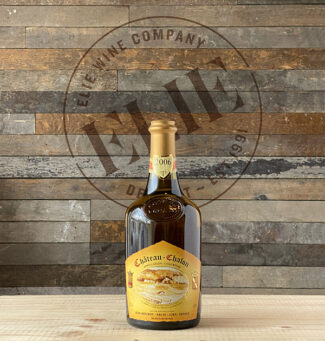 AOP Château-Chalon – 2006 ‘Vin Jaune’ ($170): Jean-François produces wines that are designed for the long haul; he believes that the semi-continental climate in which he works produces wines that need many years before they can be drunk. Typically, Bourdy wines are held back 4-5 years in barrel before they are released. The Château-Chalon ‘Vin Jaune’ is the jewel upon the crown, made without concession exactly as it was made a century ago. The vineyard is certified biodynamic and composted cow manure from their neighbor’s cows is the only fertilizer used, while vine disease is controlled by a mixture of whey and flower teas. The 2006 Château-Chalon has been described as having ‘one of the most complex noses in all the world of wine.’
AOP Château-Chalon – 2006 ‘Vin Jaune’ ($170): Jean-François produces wines that are designed for the long haul; he believes that the semi-continental climate in which he works produces wines that need many years before they can be drunk. Typically, Bourdy wines are held back 4-5 years in barrel before they are released. The Château-Chalon ‘Vin Jaune’ is the jewel upon the crown, made without concession exactly as it was made a century ago. The vineyard is certified biodynamic and composted cow manure from their neighbor’s cows is the only fertilizer used, while vine disease is controlled by a mixture of whey and flower teas. The 2006 Château-Chalon has been described as having ‘one of the most complex noses in all the world of wine.’
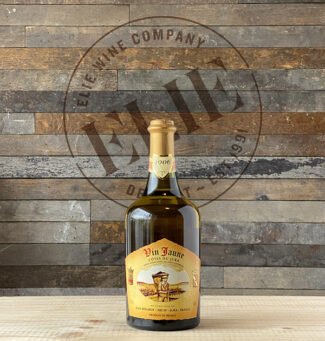 AOP Côtes du Jura – 2006 Vin Jaune ($140): A slightly less exclusive Vin Jaune, yet still in the stratosphere of quality—this wine is a rich, unctuous and rare treat for the dinner table. After many years in barrel under the flor veil, considerable evaporation occurs, and what ends up in the Vin Jaune bottle is just 50% of the fruit that was harvested. The wine is soft upon entry with thick apple-butter notes, but puckering and rich with acidity on the finish, leaving flavors of tart melon and lemon skin.
AOP Côtes du Jura – 2006 Vin Jaune ($140): A slightly less exclusive Vin Jaune, yet still in the stratosphere of quality—this wine is a rich, unctuous and rare treat for the dinner table. After many years in barrel under the flor veil, considerable evaporation occurs, and what ends up in the Vin Jaune bottle is just 50% of the fruit that was harvested. The wine is soft upon entry with thick apple-butter notes, but puckering and rich with acidity on the finish, leaving flavors of tart melon and lemon skin.
Climate Change Threatens Wine, and a Way of Life, in Jura
“It is truly a disaster, and people are angry because there is suddenly so much demand, but not enough wine to sell.”
These prophetic words were uttered by Fabrice Dodane of Domaine de Saint-Pierre in Arbois—they capture a cruel reality that has descended upon the Jura just as the wine world is becoming enamored of the idiosyncratic marvels from this minute corner of France: Climate change. The Jura’s semi-continental climate is built around cold winters and dry summers, and the native varietals that have laid the foundation for the Jura’s unique style require these conditions to thrive. Warmer winters play havoc with budburst, causing early blossoming; a frost can destroy an entire harvest overnight. And the fruit lucky enough to survive spring is often struck by outbreaks of mildew as summers see more rain.
The Fruitiere Vinicole Arbois, a collective of 100 wineries, reports a steady decline in Jura’s output since 2017; while the cooperative typically produces around 475,000 gallons of wine after a normal harvest, in 2017, its yield fell to 185,000 gallons and 2021 brought in only 119,000 gallons. “We are living a true crisis in the Jura,” says Gabriel Dietrich, director of the cooperative. “Some winegrowers weren’t even able to harvest this year, because they had nothing.” This has put tremendous pressure on winegrowers to sustain production, and many are struggling to stay afloat. Four revered winemakers ended their lives this year.
To us, this means that these wonderful wines from one of France’s most remarkable and tiniest regions are all the more precious and all the more worth supporting.
- - -
Posted on 2022.01.17 in Jura, Arbois, Macvin du Jra, L'Étoile, Château-Chalon, Macvin du Jura, France, Wine-Aid Packages | Read more...
Champagne & Food Pairing Notebook: To the Test at Restaurant ‘Bunny Bunny’ in Detroit’s Eastern Market
Notebook
A’Boudt Town
A chronicle of the early history of The New Yorker magazine, Ben Yagoda’s ‘About Town’ recounts a universe inhabited by writerly types perennially sipping something between bouts of literary greatness.
Nabokov favored tawny port while the out-of-print humorist Peter De Vries preferred Piesporter, Joseph Rosenblum notes in his review of the book.
I’m a wine merchant, not a novelist. But the stories locked in the bottles lining the walls of my shop can be just as layered and demanding as the most assertive prose, each one telling of a specific time in history and place in the world.
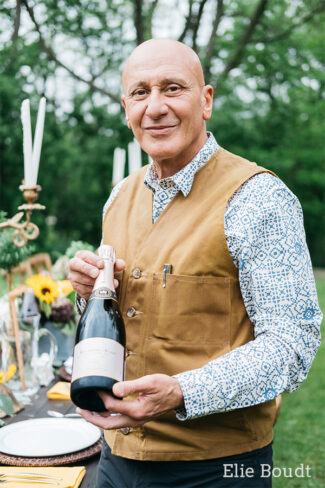 At Elie Wine Co., we know most of our producers personally, so the stories here go deeper — often to family, tradition, excellence, and craft.
At Elie Wine Co., we know most of our producers personally, so the stories here go deeper — often to family, tradition, excellence, and craft.
And then there is the story of Champagne, which, both despite and because of its outsized reputation, is today one of the most underappreciated, misunderstood and unfairly pigeonholed regions and classes of wine in the world.
Perhaps because of its long affiliation with European aristocracy, Champagne has been unfairly caged by notions of luxury and opulence that, frankly, don’t apply to many of the humble men and women making the most riveting expressions of it today.
So, let’s first dispel any notions that Champagne must be a luxury item only for special occasions. While it does pair well with celebratory caviar, Champagne can also be the perfect foil for spicy Indian carryout or crispy fried chicken.
In A’Boudt Town, you will find me, Elie Boudt, deepening our understanding of Champagne while having fun with a beverage that immediately elevates any moment.
Future installments of this feature will take you to a diverse range of restaurants around metro Detroit, my home for 40 years, while introducing you to today’s most exciting Champagne producers and their wines.
In the process, we’ll challenge preconceived notions of what Champagne is and can be, and introduce the idea that — despite Champagne’s long history — the best may yet still be ahead.
Champagne & Food Pairing
Restaurant ‘Bunny Bunny’ in Detroit’s Eastern Market
For our first installment of A’Boudt Town, we aimed our sights far beyond what might be thought of as traditional Champagne food — no oysters, no caviar, and no special occasion to celebrate.
It was an otherwise uneventful Wednesday until our casual dinner at Bunny Bunny in Eastern Market, where chefs Jennifer Jackson and Justin Tootla were previewing a directional shift in their cooking, moving from the by-the-book regional Chinese cuisine they launched with a more personal approach that highlighted Justin’s family roots in northern India in particular.
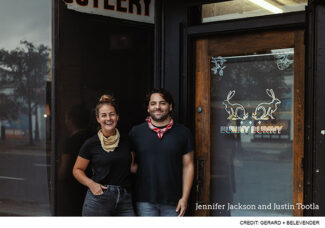
For our first installment of A’Boudt Town, we aimed our sights far beyond what might be thought of as traditional Champagne food — no oysters, no caviar, and no special occasion to celebrate.
It was an otherwise uneventful Wednesday until our casual dinner at Bunny Bunny in Eastern Market, where chefs Jennifer Jackson and Justin Tootla were previewing a directional shift in their cooking, moving from the by-the-book regional Chinese cuisine they launched with a more personal approach that highlighted Justin’s family roots in northern India in particular.
Pierre Paillard produces about 7,500 cases a year of Bouzy Champagne and is not to be confused with the much larger producer, Bruno Paillard, which blends across villages in Reims.
We sampled three cuvées from Paillard: the non-vintage, Pinot Noir-dominated ‘Les Parcelles XVI’; the 2014 ‘Les Mottelettes’ Blanc de Blancs, made from single-vineyard old-vine Chardonnay; and the ‘Les Terres Rose XVII,’ a unique Champagne rosé made by adding a small amount of still red pinot noir to the base wine.
At Paillard, Roman numerals on non-vintage bottles indicate the year of the base wine, typically 80% of the blend, lending rare insight into even its blended wines.
All of the wines spend extended time sur lie, and dosage for all is in the extra-brut range.
We opened the ‘Les Parcelles’ first. A 70/30 blend of Pinot Noir and Chardonnay, this was the broadest-shouldered of the bunch. Citrus-centric and showing dried fruit before its creamy, lingering finish.
‘Les Parcelles’ saline minerality paired exceptionally well with a dish of chilled clams dressed with uni-like globs of vadouvan yogurt and slivers of fresh asparagus lightly marinated in chili oil. Asparagus can be problematic to pair, but the wine overcame this by accentuating the brininess of the dish instead. A welcome start on both fronts.
Generally, ‘Les Parcelles’ aromatized the herbaceous green notes of the cuisine, especially in a vibrant cold chicken dish inspired by Naga-style pork, which includes hunks of fermented bamboo mixed with ginger, mint, and chilis.
‘Les Mottelettes’ was much softer on the palate, as expected of a Blanc de Blancs, but showed much more umami-like characteristics and less citrus than ‘Les Parcelles.’ Incidentally, 2014 was a problematic vintage in Bouzy, with a cold and rainy summer, but that didn’t seem to affect the Chardonnay.
While ‘Les Parcelles’ aromatized the greens in the food, ‘Les Motelletes’ did not, acting almost as a palate volume dial. Its oxidative and autolytic characters allowed the spices to be heard, but the acid kept them in check, even when paired against a dry chili chicken dish studded with tongue-numbing Szechuan peppercorns. Many wines would not hold up, but somehow the pairing here only magnified the fruit characteristics of the wine.
The Rosé was vinous, perfumed and creamy, exhibiting a gentle moelleux. It played very well with one of the standout dishes of the night, a wok-fried tandoori chicken, smokey and slathered in tamarind sauce that recalled Southern American barbecue. The perceived sweetness in the wine brought out the meaty flavors of the fall-apart chicken and stood up to the sweetness in the dish itself.

Somehow, none of the food overpowered any of the wines. And though each served a different purpose, the 2014 Blanc de Blancs was the most dexterous of the bunch despite its more narrow focus. And now we see why Paillard remains committed to Chardonnay in Bouzy.
Still, each of the wines had a texture that was present, a beautiful dance between light and loud. Inherently, when you drink wine with bubbles, it just seems to be light. But there’s an interplay between light and loud that’s brought out by pairing Champagne with the spicy food and the dance here was quite enjoyable. Champagne is high in acid, which tends to cut through fat, salt, and spices, but here it somehow also made the food more vibrant and assertive.
One of the most beautiful aspects of any Champagne is the fact that its very presence elevates any moment, its bubbles lifting even a weekday dinner to its own cause for celebration.
And we certainly celebrated at Bunny Bunny. Even if it was a Wednesday.
Bunny Bunny – 1454 Gratiot Ave, Detroit, Michigan 48207 USA – (313) 974 6122
Champagne, Considered
Champagne is undergoing an attitude renaissance, and much of the evolution is driven by consumers. Throughout the world of still wines, the focus is shifting toward improved agriculture, with organic and biodynamics creating sustainable terroir conditions. Champagne is doing likewise of course, along with promoting grower estates, small houses, reduced dosages and single-vineyard bottlings. But Champagne has long lived inside a rarefied world where much of its mystique was based on perception; its special-occasion aura, if consumers knew about much about the estates themselves, it was generally their ‘house style’—largely the result of winemaking technique. Bollinger spends more time on lees, for example, making it more yeasty in the mouth while Pol Roger allows fruit and floral notes to take the diva role by limiting lees contact. Reductive Champagnes like Salon do not undergo malolactic fermentation whereas oxidative wines, mostly Pinot Noir-based, are often oak aged, and taste rounder and sweeter.
What often gets lost amid the raised flutes and celebratory glitter is that Champagne is, first and foremost, wine, and as such, is highly expressive of its vineyard origins—when the winemakers allow this uniqueness to shine through. House styles have traditionally focused less on a reflective sense of the land on which the grapes were grown, and this is something that contemporary Champagne houses are beginning to explore, exploit, and advertise.
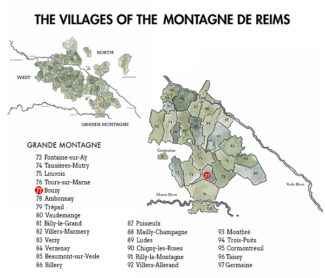
Each of the wines in this package is ‘climat’ specific, meaning that the grapes come from vineyard parcels as designated by the labels. It is a single Champagne house producing a variety of sparkling wines that emphasize—above all—a sense of place. These wines are expressive of various lieux-dits in and around the village of Bouzy; they are all classified as Grand Cru. Bouzy is one of the only 17 Grands Crus of the 320 villages, which make up Champagne’s seven sub-regions. (See Map Here)
Champagne Pierre Paillard
Bouzy – Grand Cru
(Grande Montagne in The Montagne de Reims)
Paillard is a familiar name to fans of Champagne; Maison Bruno Paillard, the Reims-based producer, was founded in 1981 by Bruno Paillard and financed by the sale of Bruno’s Mark II Jaguar. The Bouzy branch of the family (they are cousins) have been at it a bit longer; Antoine Paillard first bought Bouzy vineyards in 1768. Antoine and Quentin Paillard represent the eighth generation in the family and the fourth generation to produce and bottle Champagne under the family name.
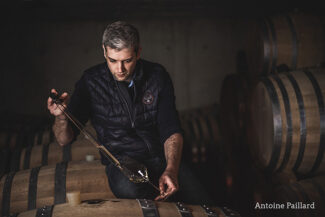
Bouzy is renowned for producing some of the finest Pinot Noir in Champagne, due in the main to its situation on the south-facing side of the Montagne de Reims, ideal for the difficult to ripen Pinot Noir grape. Nevertheless, unlike most other growers in the appellation, the 25 Paillard acres are planted with 40% Chardonnay, giving their wines both finesse and elegance.
Interestingly, the Paillards exclusively cultivate their own selection of Pinot Noir and Chardonnay, without a single clone on the estate, a diverse Selection Massale. Each plot is harvested and vinified separately in stainless steel vats and fermentation is carried out at lower temperatures to retain the aromatics. Each spring, a long process of tasting and blending is undertaken by Antoine and Quentin; the still wine is tasted, marked and discussed until there is consensus on the profile of the vintage. Blind tastings continue until the creation of each final cuvée. In June they are put into bottle for the second fermentation and cellared for a minimum of 3 years and as much as 10 years before being disgorged.
Champagne Pierre Paillard produces five cuvées. Two are non-vintage: Brut Grand Cru, generally a blend of two years and containing 60% Pinot Noir and 40% Chardonnay, and Brut Rosé, with a base of 70% Chardonnay, 23% Pinot Noir, and 7% Bouzy Rouge Pinot Noir. There are three vintage wines—a Blanc de Noirs from a single 0.8-acre parcel called ‘Les Maillerettes’ (planted in 1970), a Blanc de Blancs from a 1.5-acre parcel called ‘Les Mottelettes’ (planted in 1961) and a vintage wine that is only made in the best years and aged for seven to ten years before being disgorged.
A Note on Vintages:
2008: An icy December the previous year led to an even colder January. Below-average temperatures continued into the spring, and it did not warm up until May. But flowering was not affected and some summer outbreaks of oidium and mildew were quickly handled. August was cool, but by the mid-September harvest, the grapes were in perfect health. The vintage proved spectacular and is widely considered to be one of the top two vintages of this century so far.
2014: Dry conditions early got the growing season off to a healthy start, with a successful budburst and flowering were successful. The summer was not so kind, being cool and wet, with only the latter half of August eventually drying out. Although the rain was enough to make rot a concern, cooling breezes fortunately kept it at bay, and a benign September brought warm, dry conditions for ripening the grapes and effectively saving the harvest.
2016: 2016 was a difficult growing season, with early frosts and heavy rains between May and July putting much of the crop at risk. Conditions improved by August, but blistering heat further reduced yields. The grapes that remained were healthy, and overall, the quality was good, with wines displaying rich fruit and some nice acidity.
nv Champagne Pierre Paillard ‘Les Parcelles XVI’ Grand Cru – Bouzy Extra Brut ($57)
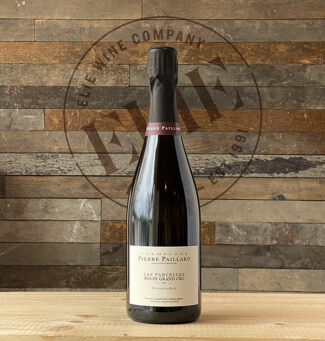 (Disgorgement: March 2021, Base Wine: 2016) Produced from 22 individually vinified parcels with their own vineyards, entirely in Bouzy, ‘Les Parcelles’ is a blend of 70% Pinot Noir and 30% Chardonnay, with 30% reserve wine. It is dosed at 1 gram per liter and has spent a full four years sur-lie prior to disgorgement. It’s an accurate portrait of Bouzy terroir with apple and salty stone-fruit notes. Citrus appears towards the finish, accented with herbs and chalk.
(Disgorgement: March 2021, Base Wine: 2016) Produced from 22 individually vinified parcels with their own vineyards, entirely in Bouzy, ‘Les Parcelles’ is a blend of 70% Pinot Noir and 30% Chardonnay, with 30% reserve wine. It is dosed at 1 gram per liter and has spent a full four years sur-lie prior to disgorgement. It’s an accurate portrait of Bouzy terroir with apple and salty stone-fruit notes. Citrus appears towards the finish, accented with herbs and chalk.
nv Champagne Pierre Paillard ‘Les Terres Roses XVII’ Grand Cru – Bouzy Rosé Extra Brut ($73)
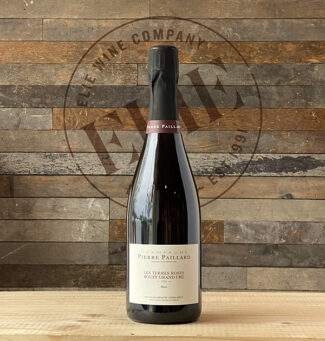 Disgorgement: April 2020, Base Wine: 2017) The delicacy and refinement inherent in this Rosé is the result of the cuvée, 64% Chardonnay, and 36% Pinot Noir vinified white. It’s dosed at 2 grams per liter but is quite dry, making it an ideal companion to shellfish, especially lobster. The nose is yeasty, like freshly baked brioche, and the palate displays a leesy undercurrent along with blood-orange and tangerine flavors before a clean and acidic finish.
Disgorgement: April 2020, Base Wine: 2017) The delicacy and refinement inherent in this Rosé is the result of the cuvée, 64% Chardonnay, and 36% Pinot Noir vinified white. It’s dosed at 2 grams per liter but is quite dry, making it an ideal companion to shellfish, especially lobster. The nose is yeasty, like freshly baked brioche, and the palate displays a leesy undercurrent along with blood-orange and tangerine flavors before a clean and acidic finish.
2014 Champagne Pierre Paillard ‘Les Mottelettes’ Grand Cru – Bouzy, Blanc de Blancs Extra Brut ($93)
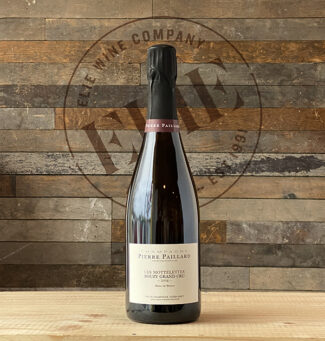 (Disgorgement: February 2019) From a miniscule plot of Chardonnay planted in 1961 in the lower part of Bouzy, where the pure chalk lays only twenty inches beneath the topsoil, the wine is pale golden in color with salted almond, apricot, pastry and fresh ginger notes beneath a delicate mousse. Dosage is at 1 gram/liter, with about 3000 bottles produced.
(Disgorgement: February 2019) From a miniscule plot of Chardonnay planted in 1961 in the lower part of Bouzy, where the pure chalk lays only twenty inches beneath the topsoil, the wine is pale golden in color with salted almond, apricot, pastry and fresh ginger notes beneath a delicate mousse. Dosage is at 1 gram/liter, with about 3000 bottles produced.
2016 Champagne Pierre Paillard ‘Les Maillerettes’ Grand Cru Bouzy, Blanc de Noirs Extra Brut ($91)
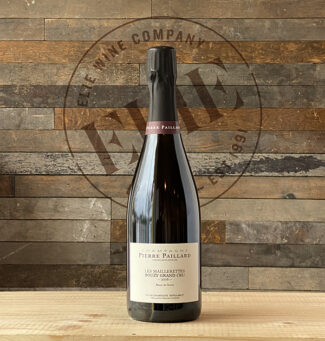 (Disgorgement: February 2021) ‘Les Maillerettes’ is a single half-acre of old vine Pinot Noir planted in 1970; the calcareous soils are made evident in the wine’s sleek structure and saline complexity. ‘Les Maillerettes’ spent 5 years on lees before disgorgement and is a proud representative of Bouzy Blanc de Noir, full-bodied and fleshy with fruit, especially cherries. Dosage: 1 gram/liter; around 2000 bottles and 122 magnums produced.
(Disgorgement: February 2021) ‘Les Maillerettes’ is a single half-acre of old vine Pinot Noir planted in 1970; the calcareous soils are made evident in the wine’s sleek structure and saline complexity. ‘Les Maillerettes’ spent 5 years on lees before disgorgement and is a proud representative of Bouzy Blanc de Noir, full-bodied and fleshy with fruit, especially cherries. Dosage: 1 gram/liter; around 2000 bottles and 122 magnums produced.
2008 Champagne Pierre Paillard ‘La Grande Récolte’ Millésime Grand Cru – Bouzy Extra Brut ($99)
 (Disgorgement: March 2021) 55% old vine Pinot Noir and 45% old vine Chardonnay from two sites on the south-facing slope of the mountain of Reims. The Pinot Noir comes ‘Les Maillerettes’ and the Chardonnay comes from ‘Les Mottelettes’ and represent the mother vines used for the massal selections made in-house at Champagne Pierre Paillard. Both vineyards are less than an acre in size, and the wine represents the quintessence of house style and terroir. A rare Champagne that may benefit from decanting, ‘La Grande Récolte’ is dosed at 1 gram per liter, and spent 8 years on lees before disgorgement. About 12,000 bottles made
(Disgorgement: March 2021) 55% old vine Pinot Noir and 45% old vine Chardonnay from two sites on the south-facing slope of the mountain of Reims. The Pinot Noir comes ‘Les Maillerettes’ and the Chardonnay comes from ‘Les Mottelettes’ and represent the mother vines used for the massal selections made in-house at Champagne Pierre Paillard. Both vineyards are less than an acre in size, and the wine represents the quintessence of house style and terroir. A rare Champagne that may benefit from decanting, ‘La Grande Récolte’ is dosed at 1 gram per liter, and spent 8 years on lees before disgorgement. About 12,000 bottles made
- - -
Posted on 2022.01.08 in Notebook: A’Boudt Town, France, Champagne | Read more...
Featured Wines
- Notebook: A’Boudt Town
- Saturday Sips Wines
- Saturday Sips Review Club
- The Champagne Society
- Wine-Aid Packages
Wine Regions
Grape Varieties
Aglianico, Albarino, Albarín Tinto, Alicante Bouschet, Aligote, Altesse, Arbanne, Arcos, Auxerrois, Barbarossa, Beaune, Biancu Gentile, Bonarda, bourboulenc, Cabernet Sauvignon, Calvi, Carcajolu-Neru, Chenin Blanc, Cinsault, Clairette, Cortese, Corvinone, Cot, Counoise, Dolcetto, Erbamat, Fiano, folle Blanche, Fumin, Gamay, Garganega, Garnacha Tintorera, Godello, Graciano, Grenache, Grenache Blanc, Grolleau, Groppello, Jacquère, Juan Garcia, Lladoner Pelut, Macabeo, Maconnais, Malbec, Malvasia, manseng, Marcelan, Marsanne, Marselan, Marzemino, Melon de Bourgogne, Mencía, Merlot, Montepulciano, Montònega, Moscatell, Mourv, Mourvèdre, Muscadelle, Muscat, Natural, Nebbiolo, Nero d'Avola, Niellucciu, Palomino, Parellada, Patrimonio, Pecorino, Pedro Ximénez, Persan, Petit Meslier, Pineau d'Aunis, Pinot Auxerrois, Pinot Blanc, Pinot Gris, Pinot Meunier, Pinot Noir, Pouilly Fuisse, Pouilly Loche, Riesling, Rousanne, Sagrantino, Sangiovese, Sauvignon, Sciacarellu, Semillon, Serine, Sumoll, Tempranillo, Teroldego, Timorasso, Trebbiano Valtenesi, Treixadura, trepat, Trousseau, Ugni Blanc, Vermentino, Viognier, Viura, Xarel-loWines & Events by Date
- September 2025
- August 2025
- July 2025
- June 2025
- May 2025
- April 2025
- March 2025
- February 2025
- January 2025
- December 2024
- November 2024
- October 2024
- September 2024
- August 2024
- July 2024
- June 2024
- May 2024
- April 2024
- March 2024
- February 2024
- January 2024
- December 2023
- November 2023
- October 2023
- September 2023
- August 2023
- July 2023
- June 2023
- May 2023
- April 2023
- March 2023
- February 2023
- January 2023
- December 2022
- November 2022
- October 2022
- September 2022
- August 2022
- July 2022
- June 2022
- May 2022
- April 2022
- March 2022
- February 2022
- January 2022
- December 2021
- November 2021
- October 2021
- September 2021
- August 2021
- July 2021
- June 2021
- May 2021
- April 2021
- March 2021
- February 2021
- January 2021
- December 2020
- November 2020
- October 2020
- September 2020
- August 2020
- July 2020
- June 2020
- May 2020
- April 2020
- March 2020
- February 2020
- January 2020
- December 2019
- November 2019
- October 2019
- September 2019
- August 2019
- July 2019
- June 2019
- May 2019
- April 2019
- March 2019
- February 2019
- January 2019
- December 2018
- November 2018
- October 2018
- September 2018
- August 2018
- July 2018
- June 2018
- May 2018
- April 2018
- March 2018
- February 2018
- January 2018
- December 2017
- November 2017
- October 2017
- September 2017
- August 2017
- July 2017
- June 2017
- May 2017
- April 2017
- March 2017
- February 2017
- January 2017
- December 2016
- November 2016
- October 2016
- September 2016
- August 2016
- July 2016
- June 2016
- May 2016
- April 2016
- March 2016
- February 2016
- January 2016
- December 2015
- November 2015
- October 2015
- September 2015
- August 2015
- July 2015
- June 2015
- May 2015
- April 2015
- March 2015
- February 2015
- January 2015
- December 2014
- November 2014
- October 2014
- September 2014
- August 2014
- July 2014
- June 2014
- April 2014
- March 2014
- February 2014
- January 2014
- December 2013
- November 2013
- October 2013
- September 2013
- August 2013
- July 2013
- June 2013
- May 2013
- April 2013
- March 2013
- February 2013
- January 2013
- December 2012
- November 2012
- October 2012

